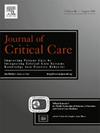对 COVID-19 患者来说,7 毫升/千克体重或更高的潮气量可能是安全的
IF 3.2
3区 医学
Q2 CRITICAL CARE MEDICINE
引用次数: 0
摘要
目的新型冠状病毒疾病(COVID-19)再次引发了关于急性呼吸窘迫综合征(ARDS)期间最佳潮气量的争论。一些专家建议所有患者的预测体重(PBW)为 6 mL/kg,而另一些专家则建议达标>50 mL/cmH2O的患者为 7-9 mL/kg PBW。我们研究了潮气量≥ 7 毫升/千克 PBW 对 COVID-19 患者是否安全,尤其是那些顺应性为 >50 毫升/厘米水的患者。材料和方法这项多中心研究的二次分析比较了使用 <7 或≥ 7 毫升/千克 PBW 通气的 600 名重症监护病房(ICU)患者的死亡率。结果 346 名患者的通气量为 <7 (6.2 ± 0.5) mL/kg PBW,254 名患者的通气量为≥7 (7.9 ± 0.9) mL/kg PBW。两组的 ICU 死亡率分别为 33% 和 29%(P = 0.272)。在多变量回归分析中,潮气量≥7 mL/kg PBW 与总体人群(几率比:0.62 [95 % 置信区间:0.40-0.95])和每个顺应性类别中较低的 ICU 死亡率相关。由于采用的是回顾性研究设计,因此应谨慎解释这一发现:试验注册:ClinicalTrails.gov NCT04388670。本文章由计算机程序翻译,如有差异,请以英文原文为准。
A tidal volume of 7 mL/kg PBW or higher may be safe for COVID-19 patients
Purpose
The novel coronavirus disease (COVID-19) has revived the debate on the optimal tidal volume during acute respiratory distress syndrome (ARDS). Some experts recommend 6 mL/kg of predicted body weight (PBW) for all patients, while others suggest 7–9 mL/kg PBW for those with compliance >50 mL/cmH2O. We investigated whether a tidal volume ≥ 7 ml/kg PBW may be safe in COVID-19 patients, particularly those with compliance >50 mL/cmH2O.
Materials and methods
This secondary analysis of a multicenter study compares the Intensive Care Unit (ICU) mortality among 600 patients ventilated with <7 or ≥ 7 mL/kg PBW. Compliance was categorized as <40, 40–50, or > 50 mL/cmH2O.
Results
346 patients were ventilated with <7 (6.2 ± 0.5) mL/kg PBW and 254 with ≥7 (7.9 ± 0.9) mL/kg PBW. ICU mortality was 33 % and 29 % in the two groups (p = 0.272). At multivariable regression analysis, tidal volume ≥ 7 mL/kg PBW was associated with lower ICU mortality in the overall population (odds ratio: 0.62 [95 %-confidence interval: 0.40–0.95]) and in each compliance category.
Conclusions
A tidal volume ≥ 7 (up to 9) mL/kg PBW was associated with lower ICU mortality in these COVID-19 patients, including those with compliance <40 mL/cmH2O. This finding should be interpreted cautiously due to the retrospective study design.
Trial registration: ClinicalTrails.gov NCT04388670.
求助全文
通过发布文献求助,成功后即可免费获取论文全文。
去求助
来源期刊

Journal of critical care
医学-危重病医学
CiteScore
8.60
自引率
2.70%
发文量
237
审稿时长
23 days
期刊介绍:
The Journal of Critical Care, the official publication of the World Federation of Societies of Intensive and Critical Care Medicine (WFSICCM), is a leading international, peer-reviewed journal providing original research, review articles, tutorials, and invited articles for physicians and allied health professionals involved in treating the critically ill. The Journal aims to improve patient care by furthering understanding of health systems research and its integration into clinical practice.
The Journal will include articles which discuss:
All aspects of health services research in critical care
System based practice in anesthesiology, perioperative and critical care medicine
The interface between anesthesiology, critical care medicine and pain
Integrating intraoperative management in preparation for postoperative critical care management and recovery
Optimizing patient management, i.e., exploring the interface between evidence-based principles or clinical insight into management and care of complex patients
The team approach in the OR and ICU
System-based research
Medical ethics
Technology in medicine
Seminars discussing current, state of the art, and sometimes controversial topics in anesthesiology, critical care medicine, and professional education
Residency Education.
 求助内容:
求助内容: 应助结果提醒方式:
应助结果提醒方式:


